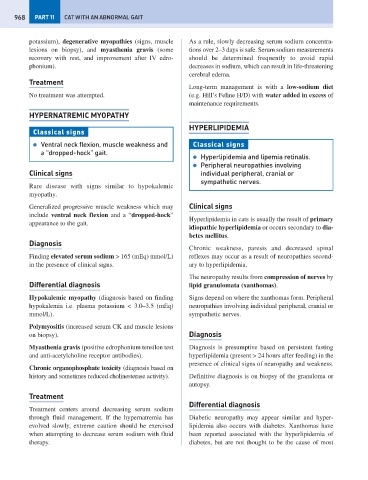Page 976 - Problem-Based Feline Medicine
P. 976
968 PART 11 CAT WITH AN ABNORMAL GAIT
potassium), degenerative myopathies (signs, muscle As a rule, slowly decreasing serum sodium concentra-
lesions on biopsy), and myasthenia gravis (some tions over 2–3 days is safe. Serum sodium measurements
recovery with rest, and improvement after IV edro- should be determined frequently to avoid rapid
phonium). decreases in sodium, which can result in life-threatening
cerebral edema.
Treatment
Long-term management is with a low-sodium diet
No treatment was attempted. (e.g. Hill’s Feline H/D) with water added in excess of
maintenance requirements.
HYPERNATREMIC MYOPATHY
HYPERLIPIDEMIA
Classical signs
● Ventral neck flexion, muscle weakness and Classical signs
a “dropped-hock” gait.
● Hyperlipidemia and lipemia retinalis.
● Peripheral neuropathies involving
Clinical signs individual peripheral, cranial or
sympathetic nerves.
Rare disease with signs similar to hypokalemic
myopathy.
Generalized progressive muscle weakness which may Clinical signs
include ventral neck flexion and a “dropped-hock”
Hyperlipidemia in cats is usually the result of primary
appearance to the gait.
idiopathic hyperlipidemia or occurs secondary to dia-
betes mellitus.
Diagnosis
Chronic weakness, paresis and decreased spinal
Finding elevated serum sodium > 165 (mEq) mmol/L) reflexes may occur as a result of neuropathies second-
in the presence of clinical signs. ary to hyperlipidemia.
The neuropathy results from compression of nerves by
Differential diagnosis lipid granulomata (xanthomas).
Hypokalemic myopathy (diagnosis based on finding Signs depend on where the xanthomas form. Peripheral
hypokalemia i.e. plasma potassium < 3.0–3.5 (mEq) neuropathies involving individual peripheral, cranial or
mmol/L). sympathetic nerves.
Polymyositis (increased serum CK and muscle lesions
on biopsy). Diagnosis
Myasthenia gravis (positive edrophonium tensilon test Diagnosis is presumptive based on persistent fasting
and anti-acetylcholine receptor antibodies). hyperlipidemia (present > 24 hours after feeding) in the
presence of clinical signs of neuropathy and weakness.
Chronic organophosphate toxicity (diagnosis based on
history and sometimes reduced cholinesterase activity). Definitive diagnosis is on biopsy of the granuloma or
autopsy.
Treatment
Differential diagnosis
Treatment centers around decreasing serum sodium
through fluid management. If the hypernatremia has Diabetic neuropathy may appear similar and hyper-
evolved slowly, extreme caution should be exercised lipidemia also occurs with diabetes. Xanthomas have
when attempting to decrease serum sodium with fluid been reported associated with the hyperlipidemia of
therapy. diabetes, but are not thought to be the cause of most

